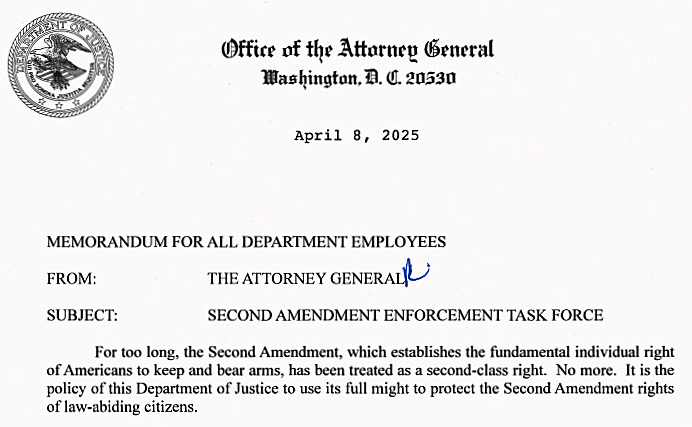Bondi's Second Amendment Task Force Blooper
The memo announcing the task force made a fundamental mistake with potentially important ramifications.
NBC News reported this week that Attorney General Pam Bondi has sent a memo throughout the Department of Justice, announcing the creation of a “Second Amendment Task Force.”
Presumably, the task force will carry out President Trump’s executive order that:
[T]he Attorney General shall examine all orders, regulations, guidance, plans, international agreements, and other actions of executive departments and agencies (agencies) to assess any ongoing infringements of the Second Amendment rights of our citizens, and present a proposed plan of action to the President, through the Domestic Policy Advisor, to protect the Second Amendment rights of all Americans.
The mistake in the memo is its statement that the Second Amendment “establishes” the right to arms.
The amendment doesn’t do that. It recognizes that the right already exists and protects it from being infringed. The amendment says “the right of the people to keep and bear arms.”
The same choice of wording occurs elsewhere in the Bill of Rights. The First Amendment recognizes “the freedom of speech, or of the press” and “the right of the people peaceably to assemble.” The Fourth Amendment recognizes “The right of the people to be secure in their persons, houses, papers, and effects, against unreasonable searches and seizures.” The Sixth Amendment recognizes that criminal defendants have “the right to a speedy and public trial, by an impartial jury.” And the Seventh Amendment recognizes that defendants in civil trials have “the right of trial by jury.” (Emphases added.)
The Supreme Court recognized in U.S. v. Cruikshank (1876) that the right to keep and bear arms existed before the Second Amendment was adopted. There, the court said:
The right there specified is that of ‘bearing arms for a lawful purpose.’ This is not a right granted by the Constitution. Neither is it in any manner dependent upon that instrument for its existence. The second amendment declares that it shall not be infringed.
The court cited Cruikshank in District of Columbia v. Heller (2008), in which it struck down the District’s handgun ban and its ban on having any gun loaded and ready for protection within the home, and blocked any other such bans at the federal level. It did so again in McDonald v. Chicago (2010), in which it incorporated the right to arms against the states and cities, striking down Chicago’s handgun ban and blocking any other such ban at the state and local levels.
Also in Heller, the court, describing the relationship between the Second Amendment’s statement that a well regulated militia is necessary to the security of a free state, and its command that the right to arms not be infringed, said:
[T]he Second Amendment’s prefatory clause announces the purpose for which the right was codified: to prevent elimination of the militia. The prefatory clause does not suggest that preserving the militia was the only reason Americans valued the ancient right. . . . But the threat that the new Federal Government would destroy the citizens’ militia by taking away their arms was the reason that right—unlike some other English rights—was codified in a written Constitution. . . . [T]he Second Amendment was not intended to lay down a “novel principl[e]” but rather codified a right “inherited from our English ancestors.” (Emphases added.)
The distinction between the amendment recognizing a preexisting right vs. establishing a right out of thin air, is more than one of semantics. Soon, the court may take one or more of the several ongoing challenges to bans on so-called “assault weapons” and ammunition magazines that hold more than 10 rounds, which have been imposed by a few states.
If the amendment created a right to arms where there was none previously, the court might take the view that what government created, government can take away. But recognizing that the amendment guarantees a preexisting right changes things significantly, or at least it should.
The Supreme Court’s recent standards for evaluating gun restrictions
Heller concluded that the amendment protects an individual right to arms based upon the amendment’s “text and history.” And in New York State Rifle and Pistol Association v. Bruen (2022), it said that for a gun restriction to be constitutional, “the government must affirmatively prove that its firearms regulation is part of the historical tradition that delimits the outer bounds of the right to keep and bear arms.”
And in a concurring opinion in Bruen, Justice Amy Coney Barrett appeared to emphasize that “history” centers on the founding era. She wrote:
[I]f 1791 is the benchmark . . . [T]oday’s decision should not be understood to endorse freewheeling reliance on historical practice from the mid-to-late 19th century to establish the original meaning of the Bill of Rights.
Worth noting, as a judge on the U.S. Court of Appeals for the District of Columbia Circuit, now-Supreme Court Justice Brett Kavanaugh dissented from the majority in Heller v. District of Columbia (2011), which upheld D.C.’s “assault weapon” ban, saying:
Heller and McDonald (v. Chicago, 2010) leave little doubt that courts are to assess gun bans and regulations based on text, history, and tradition, not by a balancing test such as strict or intermediate scrutiny. . . . Gun bans and gun regulations that are not longstanding or sufficiently rooted in text, history, and tradition are not consistent with the Second Amendment individual right.
Kavanaugh cited my submission to the court, that Americans owned upwards of two million AR-15s. Today, most of the 20-30 million semi-automatics that Democrats call “assault weapons” are AR-15s, and a ban on them is certainly inconsistent with history.
Semi-automatic firearms that use detachable magazines that hold more than 10 rounds of ammunition have existed for more than a century. The new manufacture (but not the possession of existing) AR-15s and similar firearms (in only certain, limited configurations), and magazines that hold more than 10 rounds was banned at the federal level for only 10 years (1994-2004), and they’ve never been banned in most states.
Heller’s other standard and Miller’s better one
Heller also said that the right to arms is limited to those that are “in common use.” That theory is false for four reasons: First, there is nothing in the legislative history of the right to arms to support such nonsense. Second, in the founding era, cannons weren’t common, but people owned them, and did so without any special restrictions.
Third, to pretend to justify the “common use” theory, Heller’s author, the late Justice Antonin Scalia, as I explained here, had to mischaracterize the Supreme Court’s decision in U.S. v. Miller (1939). Miller said that that the right to arms included those that relate to “the preservation or efficiency of a well regulated militia,” such as those that are “ordinary military equipment” and others the use of which “could contribute to the common defense.”
For that proposition, it cited the decision of the Tennessee Supreme Court in Aymette v. The State (1840), which, referring to the Tennessee constitution’s right to arms provision, said:
As the object for which the right to keep and bear arms is secured, is of general and public nature, to be exercised by the people in a body, for their common defence, so the arms, the right to keep which is secured, are such as are usually employed in civilized warfare, and that constitute the ordinary military equipment. If the citizens have these arms in their hands, they are prepared in the best possible manner to repel any encroachments upon their rights by those in authority.
But all of that would mean that the Second Amendment protects the right to keep and bear the most “ordinary military” rifle today, the M16. Justice Scalia wanted to justify the 1986 ban on new M16s, so he focused instead on Miller’s observation that historically, when members of the militia were called to service, they “were expected to appear bearing arms supplied by themselves and of the kind in common use at the time.” That allowed him, in a single stroke, to overturn the District’s handgun ban because handguns are “common” and to justify banning M16s because they are not (without pointing out they are not common because they are so heavily restricted).
Fourth, the “common use” theory is illogical. As Justice Stephen Breyer said in his otherwise off-base dissent in Heller:
[W]hat sense does this approach make? According to the majority’s reasoning, if Congress and the States lift restrictions on the possession and use of machineguns, and people buy machineguns to protect their homes, the Court will have to reverse course and find that the Second Amendment does, in fact, protect the individual self-defense-related right to possess a machinegun. On the majority’s reasoning, if tomorrow someone invents a particularly useful, highly dangerous self-defense weapon, Congress and the States had better ban it immediately, for once it becomes popular Congress will no longer possess the constitutional authority to do so. In essence, the majority determines what regulations are permissible by looking to see what existing regulations permit. There is no basis for believing that the Framers intended such circular reasoning.
But “common” is what the majority said in Heller. And if there are 20-30 million “assault weapons” and hundreds of millions of magazines that hold more than 10 rounds of ammunition, that should be “common” enough to be . . . “common.”
The better standard: M16s and AR-15s are today’s muskets
The Second Amendment says that it is intended to assure “the security of a free State,” which meant “against tyranny” (for example, see Alexander Hamilton and James Madison in The Federalist #s 29 and 46, respectively). And in the founding era, everyday Americans had the same (or better) small arms as those issued to soldiers in the army.
That practice continued into the 20th century. The bolt-action Model 1903 Springfield rifle—owned by countless Americans—was adopted by the military in 1903 and continued in military service through both world wars. The M1903 is a slightly modified Model 1898 Mauser, the primary rifle used by the German army during the world wars and by numerous other nations’ armies then and thereafter. The same is true for most bolt-action rifles, most particularly the ubiquitous Winchester Model 70.
Relevant to M16s and AR-15s, since the 1920s some standard-issue rifles in the military have been automatic and semi-automatic (Thompson SMG, M2 Carbine, M14 initially, and M16 series) or semi-automatic-only (M1, M1 Carbine, both widely owned by Americans), for both categories of which the standard detachable magazines hold more than 10 rounds of ammunition.
Since the 1960s, standard-issue military rifles have been those of the M16 series, the standard magazines of which today hold 30 rounds. The AR-15, the main target of “assault weapon” bans, is identical to the M16, except that it can fire only semi-automatically.
A truly originalist Supreme Court would strike down bans on “assault weapons” and magazines that hold more than 10 rounds, and the 1986 ban on what the National Firearms Act of 1934 terms a “machinegun” as it applies to standard-issue automatic rifles, such as the M16, because those arms serve the same purpose today that late-18th century muskets did in their day.
But time will tell what the court will do, and whether Bondi—like Trump, previously a gun control supporter—will do anything with her task force to eliminate or minimize firearm restrictions that are clearly unconstitutional.
Copyright © Mark Overstreet 2025




